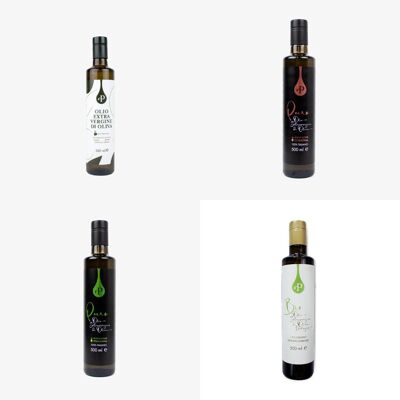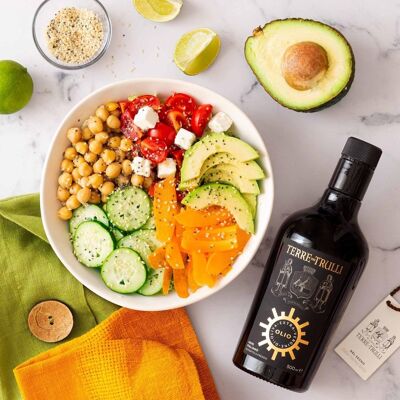

Organic Extra Virgin Olive Oil - 0.750 liter bottle
General informations Olea Europea, commonly known as the olive tree, is a plant belonging to the oleaceae family which further differs in two botanical species: Olea Europea sativaOlea Europea oleaster (more than 30 wild species). Its growth and diffusion is mainly linked to the climate, therefore to temperature and humidity, and although it is exported, the production of oil is predominant (90% of the total) in the autochthonous areas. The ripening of the fruits takes place from October (precocious species) to January (late species). Italy is a strongly olive-growing nation, so much so that, theoretically, only two regions out of twenty (Piedmont and Valle d'Aosta) are NOT characterized by the cultivation (even minimal) of the olive tree; furthermore, as can easily be understood, most of the Italian oil comes from the south of the peninsula (85% of the total): Puglia, Calabria, Basilicata, Sicily and Sardinia. The oil we produce is extracted with a mechanical process from our olives grown in Umbria from organic farming (MIPAAF authorized control body: IT BIO 007 - Controlled operator n.P37B). The olives used for the production of our oil are of the Frantoio, Leccino and Moraiolo cutivar. Nutritional values The ripe olive, therefore ready to be pressed for the production of oil, has a chemical composition which can be summarized as follows: Water 45-55%: it is the most present component in the fruit Lipids 13-28%: portion useful for the composition of the oil Nitrogenous substances 1.5-2%: Non nitrogen compounds 18-24% Crude fiber Ashes 1-2% In reality, the composition of the drupe largely depends on the level of ripeness, an aspect which affects all the components of the olive and determines the increase or decrease of the various nutritional molecules. In particular, the quantity of triglycerides enclosed in the pulp seems to undergo a significant increase (almost proportional) with the ripening and relative enlargement of the fruit. Cultivation areas The olive tree is present in ALL areas bordering the Mediterranean Sea (with some small differences, such as the north-eastern Italian Adriatic area) Storage and consumption The old people used to say: "New oil and old wine". This means that, unlike wine (which improves over time), oil best expresses its "young" qualities. It is normally thought that extra virgin olive oil can be consumed within 20 months of pressing. The law states that extra virgin olive oil must be consumed within 18 months of bottling. It is a good rule to consume the oil in the same year of production. Conservation is decisive for the duration. Even at home, where it is impossible to have an environment with a constant temperature, it is a good rule to keep it in cool, dry places, in environments with not excessive temperature ranges (it fears the heat, but it gets damaged even if the temperature drops too low), it should protected from direct light, air and heat.
L'oro in bocca store also offers


Grass pea pate - 180gr

Organic Einkorn Spelled Flour - INTEGRAL - 5000gr

Organic Einkorn Spelled - WHOLEMEAL - 5000gr

Organic Verna Soft Wheat Flour - type 2 - 5000gr

Durum Wheat Flour Antico Senatore Cappelli Biology - INTEGRAL - 5000gr

Roveja Pate - 180gr

Organic Strozzapreti - Ancient Senatore Cappelli Durum Wheat Flour - 500gr

Organic chickpeas - 400gr

Organic chickpeas - 5000gr

Organic chickpea flour - 1000gr

Organic chickpeas - 1000gr

Tagliatelle - Organic Einkorn Spelled Flour - 5000gr

Bocconotti - Organic Verna Soft Wheat Flour - 5000gr

Durum Wheat Flour Antico Senatore Cappelli Organic - INTEGRAL - 1000gr

Organic chickpea flour - 400gr

Organic Einkorn Spelled Flour - INTEGRAL - 1000gr

Organic Verna Soft Wheat Flour - type 2 - 1000gr

Organic Durum Wheat Flour Antico Senatore Cappelli - INTEGRAL - 400gr

Durum Wheat Flour Antico Senatore Cappelli Organic - type 2 - 5000gr
Products you may like

BOTTLE EXTRA VIRGIN OLIVE ORGANIC OIL 500 ML

Organic extra virgin olive oil

Bottled Extra Virgin Olive Oil - 500 ml

Bottled Extra Virgin Olive Oil - 250 ml

Extra Virgin Oil from Oilva Italiano - 750ml

Organic 100% Italian Extra Virgin Olive Oil 500 ml screw cap

Organic extra virgin olive oil

Italian Extra Virgin Olive Oil - 5L can

Italian Extra Virgin Olive Oil - 3L can

Organic Extra Virgin Olive Oil (in Can)

Extra Virgin Olive Oil 1 L - Host with rays

Extra Virgin Olive Oil 1 L - Tree cross

ORGANIC extra virgin olive oil in a 500 ML bottle

Extra Virgin Olive Oil in Can

Extra Virgin Olive Oil 0,5 L - Tree cross

Cascavilla Organic Extra Virgin Olive Oil - 250 ml

Organic Extra Virgin Olive Oil (in a bottle)

Extra Virgin Olive Oil 0,5 L - Host with rays

Olio Extravergine di Oliva - Antico Orcio 0.500 - Fruttato Intenso

